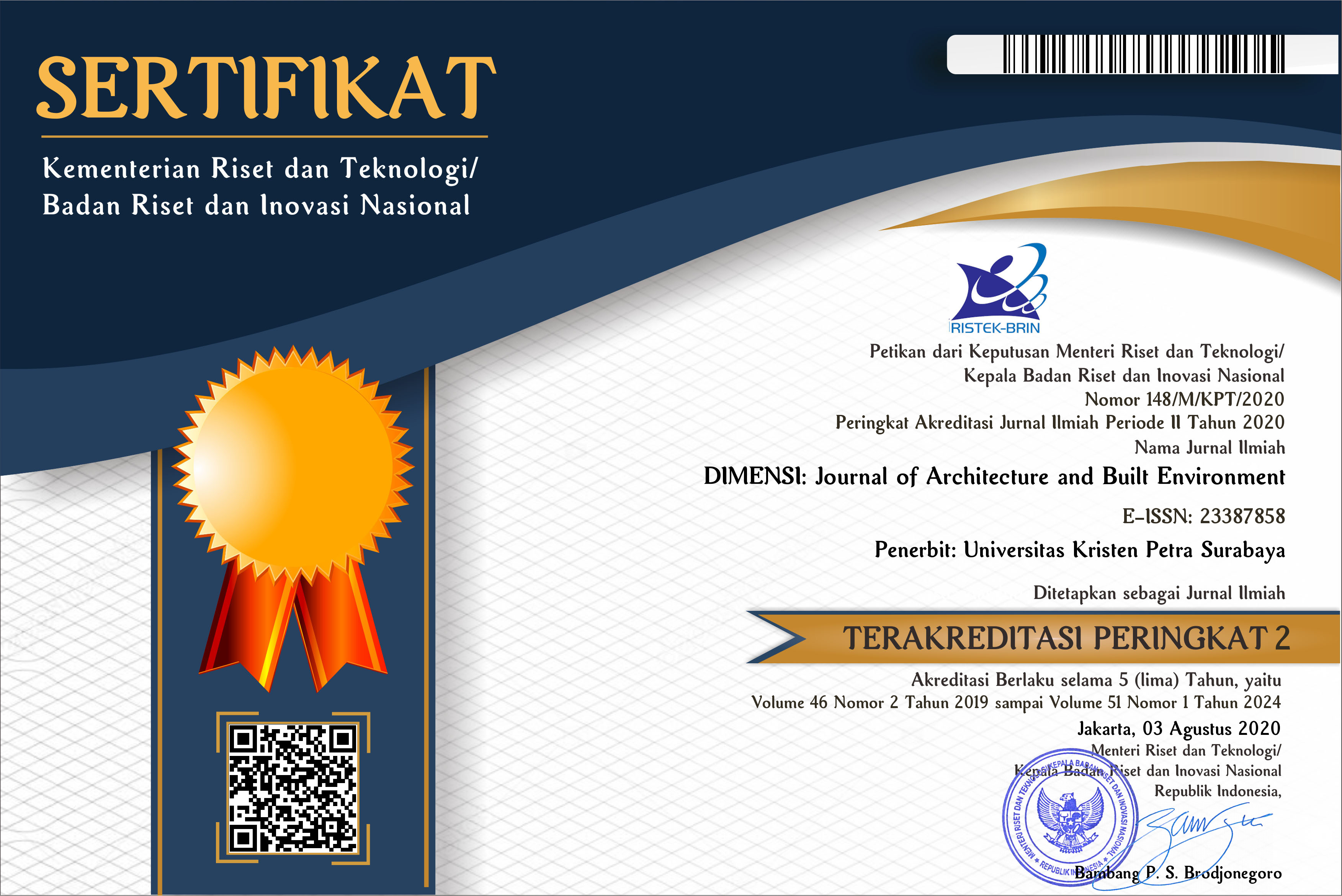THE INFLUENCE OF USER ACTIVITY AND ENVIRONMENTAL CHARACTERISTICS DIMENSIONS ON SENSE OF PLACE IN CITY PARKS
 :
:
https://doi.org/10.9744/dimensi.45.2.165-172
Keywords:
Cmpatibility with a place, dedication to a place, dimension of activity, dimension of environmental characteristics, sense of place levels.Abstract
City parks have certain environmental characteristics and accommodate various types of activities that affect the sense of place of the user. This study was conducted with the aim of identifying the dimensions of user activities and environmental characteristics, and sense of place levels related to city parks, as well as the causal relationships between them. Qualitative research was done using an online survey with open-ended questions. The collected text data were analyzed using content analysis. Quantitative research was done using an online survey with closed-ended questions that were compiled based on the results of the qualitative research analysis. The collected numerical data were analyzed by factor analysis and multivariate regression analysis. The analysis revealed four user activity dimensions (recreation, social interaction, work, and sports and hobby), seven environmental characteristics dimensions (natural environment, design, facilities, comfort, location, proximity, and entertainment), and two sense of place dimensions (compatibility with a place and dedication to a place). The dimension compatibility with a place tended to be influenced by the accessibility and visual quality of a park (location, natural environment, and park design), while the dimension dedication to a place tended to be influenced by user engagement (sport and hobby, and facilities).Downloads
References
Carr, S., Francis, M., Rivlin, L.G., & Stone, A.M. (1992). Public Space. Cambridge: Cambridge University Press.
Carmona, M. et al. (2003). Public Places-Urban Spaces, The Dimensions of Urban Design. Burlington: Architectural Press.
Creswell, J.W. (2008). Research Design: Qualitative, Quantitative, and Mixed Methods Approaches. California: Sage Publications, Inc.
Cross, J. (2001). What is Sense of Place? 12th Headwaters Conference.
Dewi Surya, S.O. (2016). Korelasi antara Aktivitas di Taman dengan Fungsi Taman serta Elemen Pendukungnya. Prosiding Temu Ilmiah IPLBI 2016. A041-A048.
Erkip, F (1997) The distribution of urban public services: the case of parks and recreational services in Ankara. Cities, 14(6), 353-361.
Galindo, M.P.G. & Rodríguez, J.A.C. (2000). Environmental Aesthetics and Psychological Wellbeing: Relationships between Preference Judgements for Urban Landscapes and Other Relevant Affective Responses. Psychology in Spain, 4(1), 13-27.
Grim, L.G., & Yarnold, P.R. (2001). Reading and Understanding Multivariate Statistics. Washington: American Psychological Association.
Gehl, J. (1987). Life Between Buildings: Using Public Space. London: Island Press.
Groat, L., & Wang, D. (2002). Architectural Research Methods. New York: John Wiley & Sons. Inc.
Hakim, R., & Utomo, H. (2003). Komponen Peran-cangan Arsitektur Lansekap. Jakarta: Bumi Aksara
Hartig, T., Book, A., Garvill, J., Olsson, T., & Garling, T. (1996). Environmental Influences on Psychological Restoration. Scandinavian Journal of Psychology, 37, 378-393.
Hashemnezhad, H., Yazdanfar, A., Heidari, A., & Behdadfar, N. (2013). Comparison the concepts of sense of place and attachment to place in Architectural Studies. Malaysia Journal of Society and Space. 107-117.
Jorgensen, B. Stedman, R. (2001). Sense of Place as an Attitude: Lakeshore Owners Attitudes Toward Their Properties. Journal of Environmental Psychology. 233-248.
Kwanda, T., Kartono, L., & Wonoseputro, C. (2014). The People’s Perceptions on Aesthetic and Uses of the Active Urban Parks in Surabaya. Dimensi - Journal of Architecture and Built Environment, 41(1), 1-10.
Korpela, K. M. (2003). Negative Mood and Adult Place Preference. Journal of Environment and Behavior, 35, 331-346.
Low, S., & Altman, I. (1992). Place Atrachment. Newyork: Plenum Press. 1-12.
Prihutami, D. (2008). Ruang Publik Kota yang Berhasil. Skripsi Sarjana Arsitektur Universitas Indonesia.
Shamai, S. (1991). Sense of Place: An Empirical Measurement. Geoforum, 22, 347-358.
Steele, F. (1981). The Sense of Place. Boston: CBI Publishing Company, Inc.
Van den Berg, A.E., Koole, S.L, & Van der Wulp. N.Y. (2003). Environmental Preference and Restoration: (How) are they related? Journal of Environmental Psychology, 23, 135-146.
Wells, N.M. (2000). At Home with Nature: Effects of ‘Greenness’ on Children’s Cognitive Functioning. Environment and Behavior, 32, 775-795.
Whyte, H.W. (2000). How to Turn a Place Around. Projects for Public Space Inc., US.
Downloads
Published
How to Cite
Issue
Section
License
Authors who publish with this journal agree to the following terms:
- Authors retain copyright and grant the journal right of first publication with the work simultaneously licensed under a Creative Commons Attribution License that allows others to share the work with an acknowledgement of the work's authorship and initial publication in this journal.
- Authors are able to enter into separate, additional contractual arrangements for the non-exclusive distribution of the journal's published version of the work (e.g., post it to an institutional repository or publish it in a book), with an acknowledgement of its initial publication in this journal.
- Authors are permitted and encouraged to post their work online (e.g., in institutional repositories or on their website) prior to and during the submission process, as it can lead to productive exchanges, as well as earlier and greater citation of published work (See The Effect of Open Access).

















